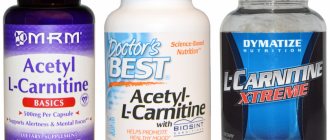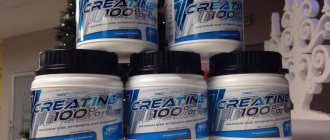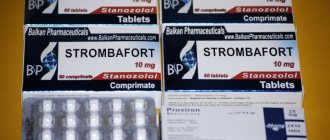The article will discuss what creatine monohydrate is, who should take it and how, what beneficial properties this substance has, and much more.
Creatine monohydrate is one of the most popular supplements among people looking to build muscle, improve performance, and increase strength.
Despite the fact that this substance is quite well studied, there is still a huge amount of misinformation about it. This guide contains only the facts about creatine monohydrate and is designed to answer all your questions.
If you have any comments or if anything is unclear, please leave comments below.
How does creatine work?
Creatine is the main source of ATP (the body's main energy substrate) in the short term during high intensity exercise. In the human body, creatine is present both in free form and in the form of creatine phosphate.
Creatine phosphate replenishes ATP stores in muscles when they contract rapidly. If muscle tissue runs out of creatine, it is unable to generate effort.
The use of creatine as an ergogenic aid is based on the theory that creatine reserves can be increased through supplementation. This is a very important point, which we will discuss below.
Combined use of creatine with other pharmaconutrients[edit | edit code]
- Creatine HMB
- Creatine and beta-alanine
- Buffer creatine
Combined use of CM and sodium bicarbonate[edit | edit code]
The combined use of CM and sodium bicarbonate (SN) was studied by JJBarber et al[40]. The prerequisites for such a combination are laid by a number of previous studies, which showed that short-term use of creatine increases physical fitness by enhancing ATP resynthesis [41][42][43], and short-term use of BN increases the buffering capacity of body fluids (muscles, in particular), reducing fatigue and increasing exercise tolerance[44][45][46]. The difference in the points of action (mechanisms) of the two substances has the potential to provide additional ergogenic benefits. Although it was already shown in the work of A. Mero et al [47] that the combination of creatine and BN increases physical fitness in swimmers at a 100-meter distance, there was a significant drawback in this study - the absence of a group using only creatine. In the work of JJBarber and his colleagues, this shortcoming was eliminated. Thirteen healthy trained men took part in a double-blind crossover study. All of them, at a certain (wash-out) interval, participated in the following options for taking nutritional supplements: (a) placebo (20 g maltodextrin); (b) creatine (20 g + 0.5 g/kg maltodextrin); (c) creatine + sodium bicarbonate (20 g creatine + 0.5 g/kg BN). Each study option lasted 2 days, followed by a washout period of 3 weeks. During testing, the following indicators were assessed: peak power, average power, relative peak power, bicarbonate concentration. The test involved six 10-second repeated sprints on a bicycle ergometer (Wingate sprint tests) with a 60-second rest period between sprints. Peak power under the influence of creatine significantly increased by 4% compared to placebo, and with the combined use of creatine and BN this advantage increased to 7%. The concentration of BN in blood plasma in the group with combined intake of creatine and BN increased by 10% compared to other groups. The authors conclude that a combination of creatine and sodium bicarbonate resulted in a greater increase in peak and average power and a reduction in relative peak power decline with repetition of exercise compared to creatine alone. Accordingly, this combination may provide additional benefits for athletes during high-intensity intermittent training.
Beneficial features
Creatine is one of the most widely researched supplements. More than 7,000 scientific articles are devoted to this topic. Hundreds of studies have proven the beneficial properties of creatine monohydrate, including:
- Increasing muscle creatine levels
- Increased performance and improved training performance
- Muscle growth
Below are detailed explanations of these properties.
Increased muscle cretin levels
In order to experience the benefits of creatine, you must replenish creatine stores in your skeletal muscles. According to recent studies, supplementation increases muscle creatine levels by 10-40%.
These results were observed after the so-called creatine loading. It involves taking the substance at a rate of approximately 0.3 g per 1 kg of body weight per day for 5-7 days and 3-5 g per day after the end of this period.
However, the practice of creatine cycling has not been shown to be very effective in maintaining elevated levels of this substance in the body.
Increased strength and performance
Creatine is currently considered the most effective legal supplement for improving anaerobic endurance and increasing lean body mass. About 70% of studies showed a significant increase in exercise capacity in people taking this substance.
In both the short and long term, creatine improves overall training performance, resulting in 5-15% increases in strength and performance. According to the results of almost all studies, proper consumption of supplements increases body weight by about 1-2 kg in the first week of creatine loading.
As the authoritative journal International Society of Sports Nutrition states, “The vast body of positive research on creatine suggests that it is the most effective supplement for building muscle mass and improving performance in high-intensity exercise.”
Creatine: a scientific review[edit | edit code]
Authors
: Doctor of Medical Sciences Alexander Vladimirovich Dmitriev, endocrinologist Alexey Alexandrovich Kalinchev
Creatine
– one of the most studied pharmaconutrients in sports medicine with a high evidence base (evidence category A), to which several hundred articles are devoted to safety and effectiveness during anaerobic and aerobic physical activity.
Currently, there are two fundamental documents for the practical use of creatine in sports:
- International Society of Sports Nutrition position stand: creatine supplementation and exercise
. Buford TW, Kreider RB, Stout JR, et al. J.Intern.Soc.Sports Nutr., 2007, 4:6.[1] - Creatine supplementation with specific view to exercise/sports performance: an update.
Cooper R., Naclerio F., Allgrove J., Jimenez AJIntern.Soc.Sports Nutr., 2012, 9:33.[2]
In addition, since 2012, a number of additional articles have been published reflecting the features of the use of creatine in certain situations and the mechanisms of influence on the body’s metabolism, the main of which are:
- The effects of creatine monohydrate supplementation on creatine transporter activity and creatine metabolism in resistance trained males
. Andre T., McKinley-Barnard S., Gann J., Willoughby DJIntern.Soc.Sports Nutr., 2020, 12(Suppl 1):P43.[3] - Effects of a traditionally-dosed creatine supplementation protocol and resistance training on the skeletal muscle uptake and whole-body metabolism and retention of creatine in males
. Gann JJ, McKinley-Barnard SK, Andre TL, et al. J.Intern.Soc.Sports Nutr., 2020, 12(Suppl 1):P2. From The Twelfth International Society of Sports Nutrition (ISSN) Conference and Expo Austin, TX, USA. 11-13 June 2020.[4]
This review is based on the basic principles of the International Society of Sports Nutrition (2007) with updates for the period of 2012, and the inclusion of research results for the period from 2012 to 2015.
Additionally, a recent review by K. Havenetidis [5] on the use of creatine in military training, based on several special studies published in the US Army Corporate Medical Journal and some regulatory documents, is briefly discussed:
- The use of creatine supplements in the military. Havenetidis KJRArmy Med. Corps. 2020, doi: 10.1136/jramc-2014-000400.
- The use of creatine supplements in the military (comments on the article by Havenetidis K.) Hill NE, Fallowfield JL, Wilson DRJRArmy Med. Corps. 2020, doi: 10.1136/jramc-2015-000482.
- Self-administration of exercise and dietary supplements in deployed British military personnel during Operation TEUC 13. Boos CJ, Wheble GA, Campbell MJ et al. JRArmy Med. Corps. 2010, 156:32-36.
- The use of exercise and dietary supplements among British soldiers in Afghanistan. Boos CJ, Simms P, Morris FR, et al. JRArmy Med. Corps. 2011, 157:229-232.
- Use of Supplements by Members of the Armed Forces. Defense Instructions and Notices. June 2012, 2012DIN01-124.
- Joint Services Steroids and Supplements Working Group: Dietary Supplements for the UK Military – A Critical Review and Positive Guidance. Child R., Fallowfield JL INM Report No 2012.011; March 2012.
How to take creatine correctly
As noted above, the purpose of taking creatine is to “saturate” the muscles with this substance. This effect can be achieved in a variety of ways, but loading seems to work best for quickly replenishing creatine stores as well as maintaining them. The dosage regimen should look like this: 0.3 g per 1 kg of body weight per day for 5-7 days and 3-5 g per day after this period.
What about the timing of taking creatine? Although it is often promoted as a pre-workout supplement, science does not support this view. Before delving into research, it’s enough to remember the very essence of creatine! It acts as an energy store, so one small dose before exercise will likely not sufficiently increase muscle mass to the extent needed to improve exercise performance.
Practice creatine loading and then maintain your creatine levels by consuming 3-5 grams per day. The timing of supplementation is not a significant factor.
In one study looking at the effect of timing of creatine supplementation on its effectiveness, 19 people were divided into 2 groups. The first took 5 grams of the substance before strength training, and the other after.
The first group showed improvements that were not observed in the second, but the differences were insignificant.
This suggests that the timing of supplementation is not a significant factor. You just need to practice creatine loading, and then go into a maintenance phase, consuming 3-5 grams per day.
How does Creatine work?
On average, the human body uses 2 g of creatine daily. During sports activities, the body's need for this substance increases. For track and field athletes, runners and bodybuilders, getting enough creatine from food is extremely difficult. After all, the decisive factor in achieving sports results is the body’s ability to release a lot of energy. For these purposes, people involved in sports use all kinds of creatine supplements or drinks with a high content of the substance. Creatine supplements come in several varieties: - Creatine hydrochlorite. - Creatine malate. - Creatine ester. — Phosphate. - Monohydrate. From a chemical point of view, creatine is a carboxylic acid that performs the functions of energy exchange between nerve and muscle tissue. Creatine for muscles is used by powerlifters, representatives of speed disciplines, weightlifters and bodybuilders. Entering the body, creatine interacts with fluoride, supplying tissues with energy. In addition to increasing endurance, taking creatine allows the athlete's body to recover quickly between difficult workouts. When creatine phosphate levels increase, athletes achieve significant gains in lean muscle mass in a short period of time. This circumstance allows obese people to use creatine for weight loss. But during the period when the supplement is taken, physical activity is required, otherwise there will be no effect.
Side effects
For years, the media has portrayed creatine as a dangerous and “obscure” supplement that can have negative health effects when taken long-term. Unfortunately, they came to these conclusions due to a lack of information.
Some of the most common accusations against creatine include dehydration, injury, digestive upset, and even kidney and liver damage. However, to date there are no controlled studies to prove this.
The only clinically identified side effect of creatine is weight gain (due to increased water concentration within cells), which is typically the goal of those who take it.
We can say that man began to consume creatine since he began to eat meat, and this happened, according to scientists, more than 1 million years ago. The research of the substance itself began more than 40 years ago, when it began to be used experimentally to treat heart diseases and improve heart function after a heart attack.
At the same time, unconfirmed information probably appeared that creatine can lead to stomach upset when taken in excessively large doses (20+ grams). However, taking the supplement with enough water or switching to higher quality brands will usually eliminate this side effect.
Discovery of Creatine
Creatine was first isolated in the first half of the 19th century, and at the beginning of the next century, scientific experiments were conducted proving that regular use of the substance increases muscle strength. At the same time, “phosphocreatine” was discovered - combined molecules of creatine and phosphate, which, when accumulated in the body, improve metabolism. The most effective form of creatine was recognized as its monohydrate - paired molecules of creatine and water.
The victorious march of creatine in sports began in 1992 after the publication of a study by Swedish doctor Eric Haltman. He has proven that taking 20 grams of creatine monohydrate daily increases muscle creatine content by 20%. A year later, an authoritative publication on sports medicine published an article about the effective use of creatine by Swedish athletes. Later studies showed that for results you do not need to take 20 grams of creatine, but 5-7 grams per day is enough. But the effectiveness of creatine has always been confirmed.
Since that time, creatine monohydrate has become a popular dietary supplement among athletes around the world. Creatine is not included in the list of prohibited doping substances, which means it can be used in any competition.
We recommend reading: What is protein and what is it for?
It is important to remember that creatine is not an essential supplement - it is produced in the body from amino acids (glycine, methionine, arginine), so there is no need to necessarily get your creatine intake from dietary supplements. In sports nutrition, creatine is obtained chemically in laboratories, but there is nothing wrong with that. The process that occurs in the body is reproduced in the laboratory and the same creatine is obtained, no less natural.
Forms of Creatine
First of all, it is worth noting that there are 2 forms of creatine: creatine monohydrate and creatine ethyl ester. Moreover, the first is much cheaper than the second. Creatine ethyl ester is often promoted as a more effective form due to increased bioavailability, however, these claims are not scientifically supported.
Both forms have been experimentally proven to increase creatine levels in muscles, but some studies suggest that creatine monohydrate may be more beneficial in this regard.
One way or another, creatine monohydrate and creatine ethyl ester are effective and very similar in their effects.
Creatine
Creatine monohydrate is the most common form of creatine, and unless otherwise noted, is the form used for all creatine studies. 14) It has fairly strong intestinal absorption and is the standard form of creatine from which all its derivatives are derived. There are only two main forms of creatine, one with the monohydrate removed (dehydrated creatine), which turns into creatine monohydrate in water. By eliminating monohydrate from the composition, 100% pure creatine is obtained. Creatine monohydrate contains only 88% creatine (and monohydrate 12%). Pure creatine is used for concentrated effects, for example, in capsules. Creatine monohydrate can also be micronized (sold as 'micronized creatine'), through a mechanical process to reduce particles and improve water solubility. As for supplements, its properties are the same as creatine monohydrate. Creatine is most often found in the form of creatine monohydrate, which is its main form and also the cheapest. It can also be micronized to improve its solubility in water, or the monohydrate can be removed from its composition to increase the concentration of creatine. None of these treatments change the properties of creatine. Creatine hydrochloride (Creatine HCl) is a form of creatine where its molecules are bound to hydrochloric acid. It is argued that in this form its dosage should be less than creatine monohydrate, although this has not been proven. Creatine hydrochloride breaks down into creatine and hydrochloric acid when it reaches the stomach, meaning it is virtually bioequivalent to creatine monohydrate. It is believed that when consuming creatine hydrochloride, a lower dosage is needed, but this has not been scientifically proven and sounds very counterintuitive, because In any case, there is hydrochloric acid in the stomach and creatine will freely separate from the acid in the stomach, the result will be the same as when consuming creatine monohydrate. Liquid creatine is less effective than creatine monohydrate.15) This is because the breakdown of creatine into creatinine takes several days, and this occurs provided that the creatine is in a solid state. This does not apply to taking creatine at home, for example, in the form of a shake. As a supplement, liquid creatine is ineffective due to its breakdown in liquid, which should not happen if you prepare creatine at home, because. this breakdown takes several days, however this process is a problem in its production. Buffered creatine (known under the brand name Kre-Alkylyn) appears to enhance the effects of creatine monohydrate due to its higher pH level, which improves translocation across the cytoplasmic membrane and also facilitates accumulation in muscle tissue. However, this has not been proven. Recent comparative analyzes of buffered creatine and regular creatine monohydrate showed no significant difference. Experiments were carried out on 36 trained people regarding the absorption of creatine by muscle tissue. No significant side effects were found. "Buffered" creatine (Kre-Alkylyn) appears to be a better absorbed form of creatine, but it can be quickly neutralized in the stomach if not enterically coated. Even if it is enterically coated, there is no evidence that it is any more effective than creatine monohydrate. Creatine ethyl ester increases muscle creatine levels to a lesser extent than creatine monohydrate. 16) It may also result in higher serum creatinine levels due to the fact that creatine ethyl ester is converted to creatinine by a non-enzymatic mechanism in an environment similar to the gastrointestinal tract. At equal doses of creatine monohydrate, ethyl ester failed to increase fluid weight after 28 days of use (an indicator of the rate of deposition of creatine in the muscles, which is absent when using ethyl ester. Creatine ethyl ester is more enriched in creatinine rather than creatine, and was originally created in an attempt to bypass the creatine transporter. It is currently being studied for the potential treatment of diseases in which there is a deficiency of creatine transporters (along with cyclocreatine as another possible example). Its effectiveness, however, may depend on intravenous administration. Direct studies of creatine ethyl ester show that it is less effective than creatine monohydrate, on par with placebo.17) Creatine ethyl ester is 82.4% creatine, and thus will provide 8.24 g of active creatine per 10 g dose. The ester is likely ineffective as a creatine supplement because, although it is able to passively diffuse across the cell membrane in vitro, it is too quickly degraded to creatinine in the intestine. Magnesium chelated creatine generally produces the same ergogenic effects as low-dose creatine monohydrate. This is because carbohydrates generally have a beneficial effect on creatine metabolism, and magnesium is also involved in carbohydrate and creatine metabolism. Magnesium chelate creatine may be beneficial in increasing muscle strength to the same extent as creatine monohydrate, but without the increase in fluid weight (differences noted, but not statistically significant). 18) Creatine magnesium chelate has proven to be better than creatine monohydrate during this time, but no further research has been conducted. Creatine nitrate is a form of creatine where a nitrate molecule (NO3) is presumably bound to a creatine molecule, and this increases solubility in water by about 10 times with a pH of 2.5 or 7.5, without significantly affecting solubility. Other than increased solubility, no other studies have been conducted using creatine nitrate. Creatine nitrate is a highly water-soluble form of creatine, and while it is theoretically possible that it combines the qualities of both creatine and nitrate, this has not yet been fully researched. Creatine citrate is creatine that is bound to citric acid or citrate. Creatine citrate is not significantly different from monohydrate in terms of absorption or kinetics. It should be noted that creatine citrate is more soluble in water than monohydrate, 19) but creatine absorption is generally not limited by solubility. Increased solubility in water can significantly improve the taste of the drug. There are different proportions of creatine to citrate: 1:1 (creatine citrate), 2:1 (dicreatine citrate), and 3:1 (tricreatine citrate). Creatine malate is a creatine molecule bound to malic acid. There may be some ergogenic benefits of malic acid, but it has not been studied in combination with creatine. Malic acid/malate also imparts a sour taste 20) and may negate the bitter sensation of some supplements. Creatine citrate and creatine malate are variants of creatine whose addition increases water solubility and possibly alters sensory (taste) properties due to its acidic irritants. Creatine pyruvate (also known as creatine 2-oxopropanoate), at isomolar doses relative to creatine monohydrate, produces higher plasma creatine levels (peak value and AUC), but does not show a noticeable difference in absorption or excretion values. The same study noted increased performance of creatine pyruvate at low (4.4 g creatine equivalent) doses compared to citrate and monohydrate, possibly due to the pyruvate group. Creatine pyruvate consists of 60% creatine. Creatine pyruvate may help achieve higher plasma creatine levels relative to isomolar doses of creatine monohydrate, but a single study found no difference in absorption (not supporting elevated serum levels) and it was not replicated. Creatine α-ketoglutarate is a creatine molecule bound to an alpha-ketoglutaric acid residue. Little research has been conducted on creatine α-CG. Creatine α-ketoglutarate consists of 53.8% creatine (mass fraction). 21) Creatine α-KG is considered an improved form of creatine (compared to argignine α-KG, which has an increased absorption rate). Creatine sodium phosphate consists of 51.4% creatine (mass fraction). Creatine sodium phosphate turns out to be half creatine. Polyethylene glycated creatine appears to be as effective as creatine monohydrate at a lower dosage (1.25-2.5g relative to 5g monohydrate), but it is not comparable in all aspects. 22) Polyethylene glycated creatine (PEG creatine) appears to be comparable to creatine monohydrate. Creatine gluconate is a form of creatine in which a creatine molecule binds to a glucose molecule. There are currently no studies conducted with this substance. Creatine gluconate is a type of glycoside of creatine and is believed to be better absorbed when taken with food, as many other gluconate molecules found in minerals such as magnesium are better absorbed from food. As mentioned above, no research has been conducted on this particular option at this time. Cyclocreatine (1-carboxymethyl-2-iminoimidazolidine) is a cyclic form of creatine analogue that has been produced synthetically. It serves as a substrate for the creatine kinase enzyme system, which acts as a creatine mimetic. Cyclocreatine may compete with creatine in the CK enzyme system in the ability to transfer phosphate groups to ADP, since the incubation period of both may reduce the anti-peristaltic effects of cyclocreatine on some cancer cells. The structure of cyclocreatine is quite flat (planar), which facilitates its passive diffusion through membranes. It has been used with success in animal studies where mice suffered from a deficiency of SLC6A8 (the creatine transporter across the blood-brain barrier), which does not respond to standard creatine. [95] This study failed to observe an increase in creatine deposition in the brain, but did note a reduction in mental retardation associated with increased deposition of cyclocreatine and phosphorylated cyclocreatine. As shown in this animal study and in previous studies, cyclocreatine is bioactive after oral administration and may simply be a creatine mimetic agent capable of phosphorylating ADP via the creatine kinase system. 23) This increased permeability has been noted in glioma cells, where there is an anticancer effect associated with cell swelling, and in other membranes such as breast cancer cells 24) and skeletal cells (contractile muscle cells). The kinetics of cyclocreatine is first order, with Vmax 90, Km 25 mM and KD from 1.2 mM. 25) In terms of bioenergetics, phosphorylated cyclocreatine appears to have less affinity for creatine kinase enzymes than phosphorylated creatine in sacrificing a high-intensity phosphate group (approximately 160 times less affinity), despite a similar phosphorization process. When added to chicken feed, phosphorylated cyclocreatine can accumulate up to 60 mM in skeletal muscle 26), suggesting sequestration of phosphate groups before reaching equilibrium. Cyclocreatine, however, still has the potential to sacrifice phosphate, since beta-adrenergic stimulation of skeletal muscle (which depletes ATP and glycogen) caused a decrease in glycogen depletion (indicative of ATP conservation) and phosphocreatine. When looking at kinetics, cyclocreatine appears to diffuse passively across membranes and is not affected by the creatine transporter, which may be useful in cases where the creatine transporter is interfering with its target (no creatine response and SLG6A8 deficiency). It acts similarly in that it can buffer ATP concentrations, but its effectiveness in healthy individuals as a supplement is currently unknown.
The best brands of creatine producers
- MUSCLETECH
Cell-Tech
- Calorie content: 180 kcal
- Creatine content: 7 g
- Carbohydrate content: 38 g
- DYMATIZE
Creatine Monohydrate
- Creatine content: 5000 mg
- NUTREX
Creatine Drive
- Creatine content: 5000 mg
- ATHLETIC EDGE
Creatine RT
- Calorie content: 5 kcal
- Creatine content: 5450 mg
- Carbohydrate content: 1 g
- PROSUPPS
Creatine
- Creatine content: 5000 mg
Benefits of creatine
- Increases strength endurance
Muscles can work on creatine phosphate synthesis for 6-15 seconds. By increasing creatine reserves in the muscles, the duration of explosive work increases by 20-30%.
When switching from creatine-phosphate energy supply to glycolysis, acidification begins. But here creatine helps out too - it delays the moment of acidification to 1 - 1.5 minutes.
- Increases muscle mass and strength
The increase in muscle mass and strength occurs indirectly due to an increase in performance. Creatine helps you work out longer, so your muscles grow faster. It is important not to confuse swelling with muscle gain. Creatine retains water and increases cell size. The muscle becomes “inflated”.
Important! The effect of creatine, like any other sports nutrition, corresponds to the load. When working on mass in the gym, it will help you gain mass. Creatine will not make a skier, track and field athlete, cyclist, or swimmer “jump,” but it will speed up recovery and increase muscle power.
- Improves muscle definition
Taking the drug allows you to improve muscle definition. This is due to both increased endurance during training and water retention - the greater the supply of creatine in the muscles, the more water it contains and the larger it looks.
- Serves as a lactic acid buffer
The familiar burning sensation after training serves as a signal that lactic acid has accumulated in the muscles. Creatine can inhibit the release of lactic acid and reduce recovery time after exercise.
- Protects the cardiovascular system
Helps restore the heart muscle after a heart attack, with arrhythmia and ischemia. Promotes vascular restoration. Protects the heart muscle when working in conditions of lack of oxygen.
- Protects the central nervous system
Helps the development of the brain and the entire nervous system. Improves the conduction function of the nervous system and the contractile function of muscles, including the heart.
- Normalizes blood cholesterol levels
We recommend reading: Why do we need bcaa and how to take it?











